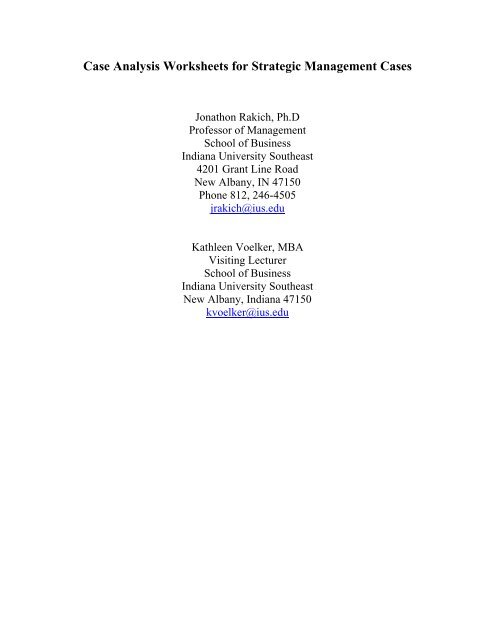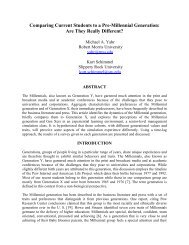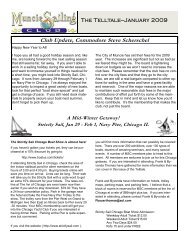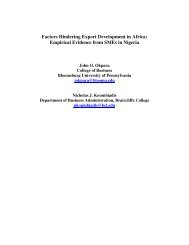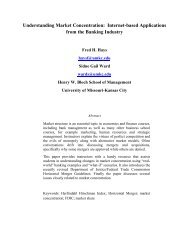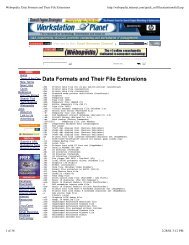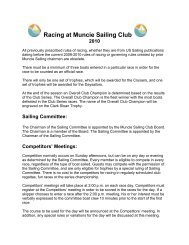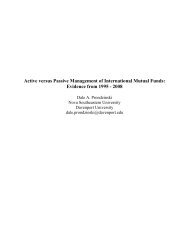Case Analysis Worksheets for Strategic Management Cases
Case Analysis Worksheets for Strategic Management Cases
Case Analysis Worksheets for Strategic Management Cases
Create successful ePaper yourself
Turn your PDF publications into a flip-book with our unique Google optimized e-Paper software.
<strong>Case</strong> <strong>Analysis</strong> <strong>Worksheets</strong> <strong>for</strong> <strong>Strategic</strong> <strong>Management</strong> <strong>Case</strong>sJonathon Rakich, Ph.DProfessor of <strong>Management</strong>School of BusinessIndiana University Southeast4201 Grant Line RoadNew Albany, IN 47150Phone 812, 246-4505jrakich@ius.eduKathleen Voelker, MBAVisiting LecturerSchool of BusinessIndiana University SoutheastNew Albany, Indiana 47150kvoelker@ius.edu
<strong>Case</strong> <strong>Analysis</strong> <strong>Worksheets</strong> <strong>for</strong> <strong>Strategic</strong> <strong>Management</strong> <strong>Case</strong>sAbstractThis paper, “<strong>Case</strong> <strong>Analysis</strong> <strong>Worksheets</strong> <strong>for</strong> <strong>Strategic</strong> <strong>Management</strong> <strong>Case</strong>s,” contains documentsprovided by the authors <strong>for</strong> use by students in the senior Business Policy course at IndianaUniversity Southeast (IUS). It is a follow up to an accounting and financial audit teaching aidand tutorial paper presented at the 2008 Academy of Business Disciplines. 1 The purpose of thispaper is to share with faculty, who teach using cases and who write cases, <strong>for</strong>ms and processesthat we have found to be successful in advancing student learning in case-oriented courses.THE WORKSHEETSThe worksheets and <strong>for</strong>ms have been classroom tested <strong>for</strong> over 5 years in our team-coordinatedsenior Business Policy course. They enable students to:• Organize case in<strong>for</strong>mation into categories and to identify salient points <strong>for</strong> each assignedcase• Derive and assess risk, per<strong>for</strong>mance, and control issues inherent in the assigned case• Use specific terminology relative to categories of objectives and strategies, as well asapply strategic management textbook concepts• Systematically analyze the current situation of a given organization and <strong>for</strong>mulate andevaluate potential courses of action to create a competitive advantage <strong>for</strong> the organization• Use a specified <strong>for</strong>mat to logically structure oral case presentations and written caseanalysis reports.Exhibit 1 presents a “<strong>Case</strong> <strong>Analysis</strong> Form” students use to systematically record and organizein<strong>for</strong>mation as they read a case. The first page focuses on the categories ofindustry/environment, as well as the traditional functional areas of business (i.e., management,marketing, finance, and production/operations). The second page of the case analysis <strong>for</strong>mcontains categories <strong>for</strong> identifying stated and implied objectives/strategies, mission, the SWOTanalysis, listing problems (or issues), and identifying potential future strategies <strong>for</strong> theorganization that is the focus of the case. Both pages of the <strong>for</strong>m are blank with the exception ofthe headers and italicized embedded items. There are numerous strategic management conceptsrelated to each and students are to apply them, as appropriate, in the written analysis. Theseconcepts are derived from the course required textbook by Hunger and Wheelen. 2 The attached<strong>for</strong>m provides examples <strong>for</strong> a typical strategic management case. Finally, each potentialstrategy is to be evaluated according to a specified circuit analysis: Will the strategy accomplishan objective, will it solve a problem or issue, and what impact the strategy would have on the1 Bauder, S., K. Voelker, and J. Rakich, “Financial Audit Teaching Aid <strong>for</strong> <strong>Case</strong> <strong>Analysis</strong>,” <strong>Case</strong>writers Workshippresentation, Proceedings of the Academy of Business Disciplines, 2008.2 Hunger, J. David and Thomas L. Wheelen. Essentials of <strong>Strategic</strong> <strong>Management</strong>, 4 th edition: Prentice Hall, 2007.1
functional areas if implemented. That is, why and how critical organizational functions must bechanged in order to implement the proposed strategic alternative.Exhibit 2 presents a worksheet that outlines three strategic management categories students’ usein their case analysis. They are generic objectives (profit, growth, citizenship, and survival),corporate strategies (<strong>for</strong>ward integration, backward integration, horizontal integration,diversification, and retrenchment), and business-level competitive strategies (cost leadership,differentiation, and focus). These objectives and strategies are fully developed in theHunger/Wheelen textbook.Exhibit 3 presents a “Financial Audit Worksheet.” The instructor provides students withindustry numbers <strong>for</strong> each ratio. Based on balance sheets and income statements contained in thecase, or provided by the instructor 3 , students calculate the company’s ratios using the definitionsin the left margin of the exhibit. Students are to interpret the calculated ratios relative to theindustry averages (a cross-sectional analysis) and the prior years’ ratios <strong>for</strong> the organization (atime-series analysis) and then draw conclusions about risk, capital structure, per<strong>for</strong>mance, andcontrol. The conclusions yield in<strong>for</strong>mation that may be appropriate in the development of theSWOT analysis and the problem/issues section of the report. (See Bauder, Voelker, and Rakich<strong>for</strong> a full explanation of ratio analysis, a sample completed financial audit worksheet withindustry ratios, and interpretation of results). 4Exhibit 4 presents a “Written <strong>Case</strong> <strong>Analysis</strong> Format” worksheet that specifies the componentsrequired in the written case report. In<strong>for</strong>mation contained in exhibits 1-3 is used when studentswrite each section in this worksheet. Together, these exhibits provide students with a process <strong>for</strong>synthesizing and integrating in<strong>for</strong>mation contained in a case. Exhibit 4 provides students with astructured <strong>for</strong>mat to use in writing (or orally presenting) a comprehensive case analysis report.Our intent is to share these documents with faculty who teach using cases or write cases. Webelieve they will find them useful.3 Income statements and balance sheets <strong>for</strong> a selected set of given years can be printed from Compustat. Recent 3or 5 year statements <strong>for</strong> publicly traded companies can be printed from www. finance.yahoo.com or www.moneycentral.msn.com4 Bauder, Susanna, Kathleen Voelker, and Jonathon Rakich. “Financial Audit Teaching Aid <strong>for</strong> <strong>Case</strong> <strong>Analysis</strong>,”<strong>Case</strong>writers Workshop presentation and Proceedings of the Academy of Business Disciplines, 2008.2
EXHIBIT 1. CASE ANALYSIS FORM (page 1) BUSINESS POLICYIndustry/Environment <strong>Management</strong> Marketing Finance (Diagnosis/Limits)How many Companies? Org. StructureDurable or Nondurable?-Simple, functional,Consolidated or Fragmented? matrix, divisional,complexConsumer or IndustrialManufacturing or Service? -Bureaucratic costs Goods?Societal Environment Forces-Political-Technological-Economic-Demographic-SocioculturalPorter’s Five Forces <strong>Analysis</strong>Bargaining Power ofBuyers and SuppliersThreat of New EntrantsThreat of SubstitutesRivalry Among Existing Firms<strong>Strategic</strong> GroupsMultidomestic or GlobalDecision Making-Proactive/reactive(mode)Phase of SrategicPlanningBoard Continuum- Phantom/CatalystBOD Resp.Exec. Leadership4 Respon. of Bus.EconomicLegalTarget market(s)?Push or Pull Strategy?Convenience, specialty,shopping:ProductPricePlace (distribution)PromotionGlobal products/globalmarkets?Product life cycleIntroduction, growth,maturity, decline1. Liquidity2. CapitalStructure3. Per<strong>for</strong>mance4. Activity5. LimitsProductionValue ChainPrimary ActivitiesInbound LogisticsOperationsOutbound LogisticsMarketing andSalesServiceSupport ActivitiesGeneralAdministrationHRMResearch, Tech, &SystemsDevelopmentProcurementOtherCorporate CultureCore CompetenciesCompetitive AdvantageLife Cycle ProgressionBCG Growth ShareMatrixTiming TacticsTriggering Event(s)Economies of Scale?Economies of ScopeIndustry Life CycleEthicalDiscretionary3
EXHIBIT 1 (CON’T) CASE ANALYSIS FORM (page 2)BUSINESS POLICYStated/ImpliedObjectives/Strategies SWOT Problems (Issues)ObjectivesProfitsGrowthCitizenshipSurvivalMissionStrategies<strong>Strategic</strong> Group?INTERNAL EXTERNALWeaknesses ThreatsLink to Value Chain/ AdverseFirm Functional areas Porter’s 5-<strong>for</strong>ces*Societal Environ.EQIC-Efficiency *New Entrants-Quality Bargain Power Supp-Innovation Bargain Power Buy-Customer RivalryResponsiveness SubstitutesFutureStrategies (Generic)Forward IntegrationBackward IntegrationHorizontal IntegrationDiversification(Concentric orConglomerate)RetrenchmentCompetitive Strategy(Cost Leadership,Differentiation, orFocus)Evaluation/Selection/ImplementationCIRCUIT ANALYSIS1. Accomplishobjectives2. Solve problem(s)3. Impact onfunctional areas(feasible?)Objective(s) AddressedIssue(s) AddressedImpact on functions-<strong>Management</strong>-Marketing-Production/operations<strong>Strategic</strong> Type?Current StrategiesCorporate-levelBusiness-LevelStrengths OpportunitiesCompetitive AdvantageousAdvantage Porter’s 5-<strong>for</strong>ces*(Resources/ Societal Environ.Capabilities)EQICLink to ValueChain-Finance-HRM-R&D-IT/MIS4
EXHIBIT 2Business Policy Categories of Objectives and StrategiesGeneric Objectives1. Profit (returns or residuals)2. Growth (sales level and/or market share)3. Citizenship (corporate culture and/or commitment/responsibility to stakeholders) includingcommunity/society)4. SurvivalA. CORPORATE STATEGIES (WHAT INDUSTRY)Hunger & WheelenGrowthConcentration→Horizontal Integration→Diversification→Retrenchment Turnaround→CaptiveSellout/DivestBankruptcyLiquidationVertical Integration (F)→Vertical Integration (B)→Horizontal Integration →Diversification→(related or unrelated)RakichGeneric Strategies1. Forward Integration2. Backward Integration3. Horizontal Integration4. Diversification(concentric or conglomerate)5. RetrenchmentStabilityPauseProceed with cautionNo change-------------------------- -------------------------------Cost leadership→Differentiation→B. BUSINESS/COMPETITIVE STRATEGY (HOW COMPETE)Broad →Broad →Narrow→→→Cost focus,Differentiation focusCost leadershipDifferentiationFocus6. Competitive Strategy– choose1 of 3; cost leadership,differentiation, orfocus (i.e., costfocus or differentiationfocus)CORPORATE STATEGIES (WHAT INDUSTRY)Method-Merger/acquisition; strategic alliances; internal development.Competitive Advantage -Resources and capabilities (value chain)Horizontal Integration = Expanding firm’s products/services into other geographic locations and/or increasing therange of products/services offered to current markets. Or, merger/acquisition (same point in the value chain).Related Diversification = Using the firm’s distinctive competence in a different industry or different product areawhere product knowledge, manufacturing capabilities, marketing skills can be applied; points of commonality maybe technology, customers, distribution, etc.Unrelated Diversification = No Connection to any value chain activities.5
EXHIBIT 3 Financial Audit WorksheetFinancial Audit <strong>for</strong>Dollars in millionsIndustryAssets $Sales $Net profit $Total DebtStockholder EquityLIQUIDITY (draw risk conclusion)Current Ratio (CA/CL)Net Working Capital (CA-CL)Quick Ratio [(CA-Inv) / CL]CAPITAL STRUCTURE (draw risk and cost of capital conclusions)Tot. Liab./Eq. [(TCL+LTD)/SE]Tot. Liab./A [(TCL+LTD)/TA]Curr.Debt/Tot.Debt (CD/TD)PERFORMANCE (look at all ingredients)Gross Profit Margin %CGS % Sales (CGS/Sales)NP % Sales (NP/Sales)RR Assets % (NP/TA)RR Net Worth % (NP/SE)SAE % Sales (Ad Ex./Sales)ACTIVITY (Draw control conclusion)Inv. Turn. (CGS/Inv.)Inv. Days O/S (365/Inv. Turn.)A/R Turn. (Sales/AR)AR Coll. (Days) (365/AR Turn.)FA Turnover (Sales/NFA)TA Turnover (Sales/TA)LIMITSStockDebtImproved Operations6
OTHER7
EXHIBIT 4Business Policy Written <strong>Case</strong> <strong>Analysis</strong> and Oral Presentation FormatStructure of <strong>Case</strong> <strong>Analysis</strong> Report1. Very brief background and overview. Include a statement of the firm’s stated or implied mission (1-2 sentences)(double space)2. Stated and implied objectives (list) (single space) [generic with example] (see Exhibit 2 <strong>for</strong> list of genericobjectives)3. Stated and implied strategies—those doing now (list) (single space) [generic with example] (see Exhibit 2 <strong>for</strong> listof generic strategies)4. Diagnostic financial audit including analysis of (a) liquidity (including risk), (b) capital structure (including riskand cost of capital), (c) per<strong>for</strong>mance, (d) activity (including control), and (e) limits (including resource availabilityfrom external sources and improved operations). [Narrative (double space); Financial Audit worksheet to beattached]5. SWOT ANALYSIS; internal and external environment assessment listing weaknesses, opportunities, threats, andstrengths (list with descriptor <strong>for</strong>mat is acceptable) (single space)6. Issue (problem) section [narrative; double space]7. Alternatives (6 strategies) [generic with example] section (list) (rejects listed first, accepted strategies follow)(single space), five corporate-level and one business-level8. Evaluation and recommendations – determine feasibility of each alternative (i.e., strategy) listed in #7 (doublespace). Circuit <strong>Analysis</strong>: Application of three tests with examples <strong>for</strong> all strategies: (a) will it accomplishobjectives; (b) will it address/solve issue (s); and (c) what is the impact of implementation on all functional areas(i.e., <strong>Management</strong>, Marketing, Production, and Finance). That is, what must be done to implement each strategy.[Note: production (operations) equals the value creation activity.]- Collect, use, and integrate appropriate in<strong>for</strong>mation from library/internet sources.* Attachments, appendices, and table of financial ratios are not counted as part of the written analysis pages. Table offinancial ratios is not required to be typed (may be hand written). First written group case analysis = 5 pages + flop;second written analysis = 6 pages + flop; third/fourth written analysis = 7 pages + flop.NOTE:A. All papers are to be typed double spaced (except where noted above) (10 or 12 cpi) with one-inch margins.Papers will be downgraded <strong>for</strong> improper grammar, spelling, punctuation, and lack of proofreading.B. An in-depth diagnostic financial audit is required. Turn in 8.5 x 14 worksheet with paper and financial auditworksheet.C. Use of concepts introduced in previous cases, lectures, and the text material is expected.8


